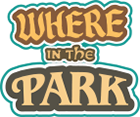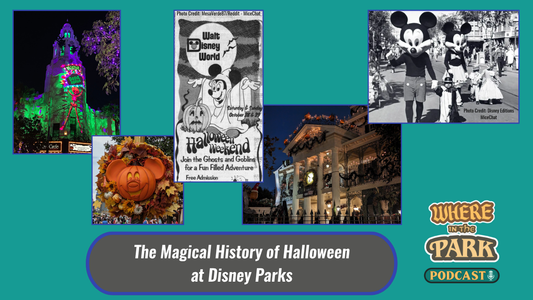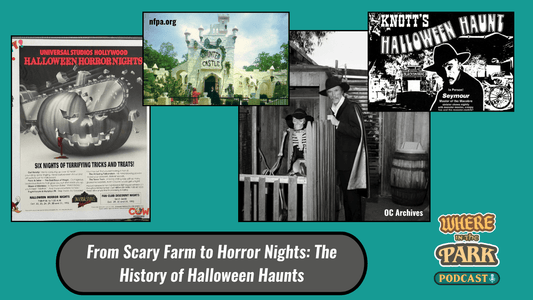Independence Hall? Knott Exactly: How Walter Knott rebuilt a symbol of freedom—almost brick for brick.
Share
When you think of Knott’s Berry Farm, you might picture roller coasters, fried chicken, and Ghost Town charm. But across Beach Boulevard, tucked quietly between Soak City and picnic benches, sits something truly unexpected: a "brick-by-brick" replica of Independence Hall, the birthplace of American democracy.

Opened on July 4th, 1966, Knott’s Independence Hall is more than a curiosity—it’s a monument to freedom, meticulously built by Walter Knott and his team as a tribute to the founding ideals of the United States.
This episode of the Where In The Park Podcast was released exactly 59 years after the replica first opened—and we decided to take a walk past the California Marketplace, through the Beach Blvd underpass to cross the street, and right past the picnic benches to explore this often overlooked slice of American (and theme park) history.
A Patriotic Vision, Realized in Brick and Timber
Walter Knott wasn’t just building an attraction. He was building a shrine.
“It is not only the most historical building in America, but it is one of our most beautiful and stately structures... Independence Hall takes us back to the very founding of our country.” – Walter Knott
It was quite the undertaking, but one that Walter Knott had always had in the back of his mind and was determined to see finished, now that he was in his 70s and the day-to-day operations of his Knott's Berry Farm were transitioning to his daughter, Marion.
To get it right, Walter instructed his team to make multiple research trips to the original building in Philadelphia. This was before color photography was common, yet hundreds of full-color images were taken, inside and out. They studied blueprints, books, and firsthand records. Paint experts worked without the benefit of modern color-matching technology. Skilled artisans handcrafted the cabinetry and furniture. City permits had to meet the strict codes of the 1960s.
And then they went one step further: they created a 14-track stereo presentation for the Declaration Chamber, simulating the debates that shaped the future of a nation. That immersive experience still plays inside today.
This Independence Hall would be (and still is) free to the public, where guests can learn about the country's history from guest speakers and docents.
So… Why Build a Replica of Independence Hall?
To fully appreciate Walter’s determination to recreate this historic building, you have to understand the legacy of the real Independence Hall.
Originally built as the Pennsylvania State House, its design is often credited to lawyer Andrew Hamilton, though some scholars now argue that Edmund Woolley, the master carpenter and principal builder, deserves the recognition. Construction began in 1732, and while the Assembly began using it by 1735, the full structure wasn’t finished until around 1748.
It was in this building that:
- George Washington accepted command of the Continental Army in 1775
- The Declaration of Independence was adopted in 1776
- The adoption of the Articles of Confederation in 1777
- The U.S. Constitution was signed in 1787
These milestones, along with the countless meetings held in the early founding of the United States, it's no wonder that this building, not the White House or Capitol, is often called the “birthplace of America.”
The Architecture: Modest, Yet Grand
The original building’s specs? A 107-foot brick façade, two 40-foot-square rooms on the ground floor (the east side was the Declaration Chamber, the west the Supreme Court Room), and a 20-foot-wide hallway in between. It was modest, even at the time, but beautifully built.
The roof was gabled and balustraded, with a cupola, not a towering steeple—until 1753, when the famous bell tower was added.
The Liberty Bell: A Sound That Shaped a Nation
Originally cast in London in 1751, the first bell cracked on arrival. Recast twice by Philadelphia founders John Pass and John Stow, the final version was hung in the tower in 1753. Inscribed on it are the words:
“Proclaim LIBERTY Throughout all the Land unto all the Inhabitants Thereof. – Leviticus 25:10”

That bell would ring for:
- The ascension of King George III
- The Stamp Act protest of 1765
- The first public reading of the Declaration in 1776 (maybe—it’s debated)
The bell would later become the icon of the abolitionist movement in the 1830s, when the name “Liberty Bell” first appeared in print.
By the 1840s, the bell from 1753 had cracked and no longer rang. But its symbolism endured.
Back to Knott’s: The Replica Bell That Almost Wasn’t
The version at Knott’s is astonishingly close. Created by Bud and Ray Hurlbut, it matches the original in size, weight (almost - it's off by 5 pounds), inscriptions, and even metal composition. Bud was even granted permission to file down part of the real bell to analyze its makeup.
Creating the crack in the replica wasn’t easy. They tried building it into the mold. No luck. Eventually, they froze the bell in dry ice, then applied a heliarc torch. That worked.
The yoke was carved from a 125-year-old slippery elm tree sourced from the Sinnissippi Forest in Illinois, matching what was used in Philadelphia at the time. The final display was based on how the bell looked in the early 1960s, right before the real bell was moved into a separate museum across from Independence Hall.
Comparing the Two Halls: A Few (Okay, a Lot of) Differences
Let’s be honest—Knott’s (and several other sources) calls it an exact replica, but...
- The quoins (cornerstones) on the real building? Missing at Knott’s.
- The closed arcades that connect to the side wings - and the side wings themselves? Not there.
- The color and translucency of the tower clock faces? Not matched.

- The second-story door and staircase on the front of the Knott’s building? Not on the original.

The gray cornerstones on the Philadelphia building are called quoins!
- The basement windows seen on the outside of the original? Not depicted at Knott's.
- The interior carvings and fireplaces? Inspired by the real ones, but much simpler. (The fireplaces can be seen in a photo below)
Even the chandelier in the Declaration Chamber is missing, and smaller details like rain spouts, keystones, and ornamental masonry were skipped. Still, for a structure built over 2,000 miles away in the 1960s, it’s impressive how close it all feels.

As we mentioned above, several sources (including the official Knott's website) say that the replica at Knott's Berry Farm is "it is the nation’s only exact replica of the Philadelphia landmark." However, this is not the case, as there is another replica at the Henry Ford Museum in Greenfield Village, Dearborn, Michigan. In our opinion, the version at the Henry Ford Museum is more accurate in the detailing, as it contains the buildings on the side and the archways between them and the main hall (albeit these are windows and not walkthrough archways), the same aquamarine clock face with cream detailing, 5x6 pane bay window, and more.

But give credit where credit is due - Walter Knott had an incredible vision, and his team pulled off an impressive feat. For many, his version will be the only one that they will see, and it is pretty darn close to the real thing.
Bonus Statue: The Minute Man (Not Washington!)
While Philadelphia’s Independence Square is home to statues of George Washington and Commodore John Barry, Knott’s instead features a bronze version of The Minute Man—originally sculpted by Daniel Chester French in 1874. The Knott’s version was created by Claude Bell, the artist behind the park’s famous bench sculptures—and the Cabazon Dinosaurs off the I-10 in California.

It honors the common colonial farmer-turned-soldier, stepping away from his plow to stand for freedom. Given Walter Knott’s own roots as a farmer, this choice feels personal.

Final Thoughts: Is It “Exact”? No. Is It Meaningful? Absolutely.
Despite a few architectural liberties (pun intended), Knott’s Independence Hall remains an impressive, educational, and often-overlooked attraction. It’s one of the most detailed replicas of its kind in the U.S., even earning a cameo in National Treasure as the stand-in for the real thing.

Note the differences in the details of the fireplace!
So, whether you’re a history buff, a Knott’s regular, or just someone who loves noticing the little details that most people miss, we highly recommend stopping by.
It’s open daily from 10 a.m. to 4 p.m., and it’s still completely free to the public, just as Walter Knott intended.
Don’t forget to catch the full episode of the Where In The Park Podcast wherever you stream your shows. We’ve got more Knott’s stories coming soon—including Ghost Town, Fiesta Village, and beyond.
Until next time… we’ll see you somewhere in the park.
✨ Articles referenced in this blog and episode: ✨
- Photos:
- Philadelphia's Independence Hall:
- Whyy.org - Bay Window
- Flickr - Liberty Bell
- Inside the clock face
- Great Tom at St. Paul's in London
- Philadelphia's Independence Hall:
- People:
- History:
- Battlefields.org - Revolutionary War - Lexington and Concord
- Chipstone.org - Brian Wilkinson, Samuel Harding, and Philadelphia Carving in the Early Georgian Style by Luke Beckerdite
- JSTOR.org - The State House Yard, and Who Owned It First after William Penn - by Charles H. Browning
- Library of Congress - The Liberty Bell, Independence Hall, Philadelphia by Charles S. Keyser
- National Park Service - The Bells and Clocks of Independence Hall
- National Park Service - Independence National Historical Park, Philadelphia, Pa. by Edward M. Riley
- National Park Service - Independence Hall Architectural Change Over Time
- National Park Service - Independence Hall Tower Rehabilitation
- National Park Service - The Minute Man statue by Daniel Chester French
- PoetryFoundation.org - Concord Hymn by Ralph Waldo Emerson
- USHistory.org - The Rising Sun Armchair (George Washington's Chair)
- Whyy.org - Look Up! The Spirit of '76 on Chestnut Street - by Alan Jaffe
- Wikipedia - Congress Voting Independence
- Wikipedia - Liberty Bell
- Knott's "only replica" sources:
- Cedarfair.com - Cedar Fair/Six Flags Merchandise - Knott's Berry Farm Liberty Bell Collectible Pin
- Knotts.com - Independence Hall



